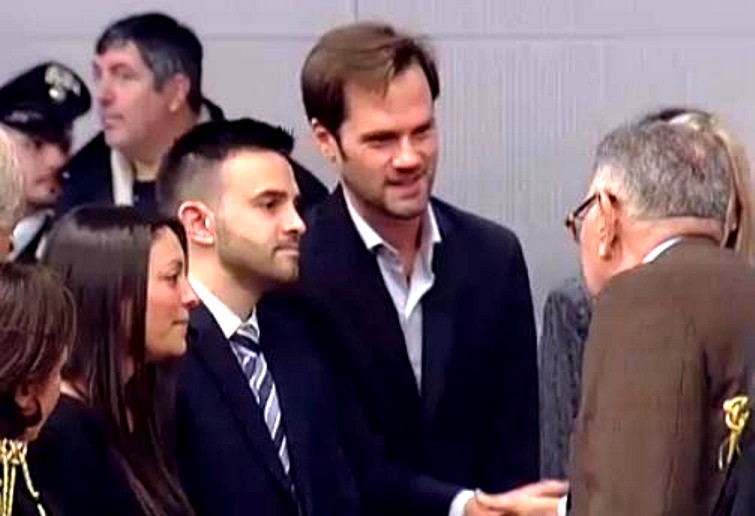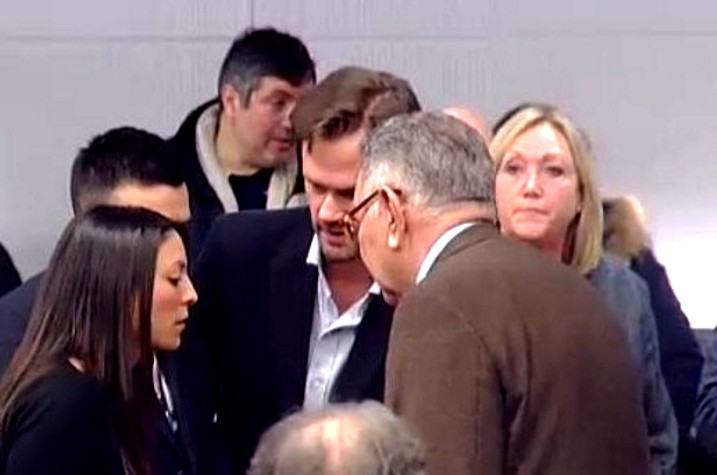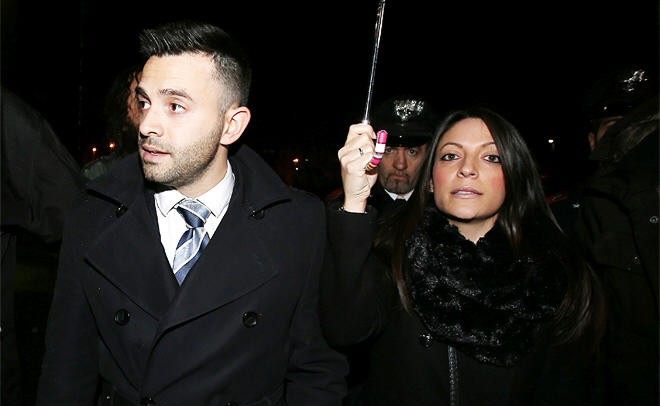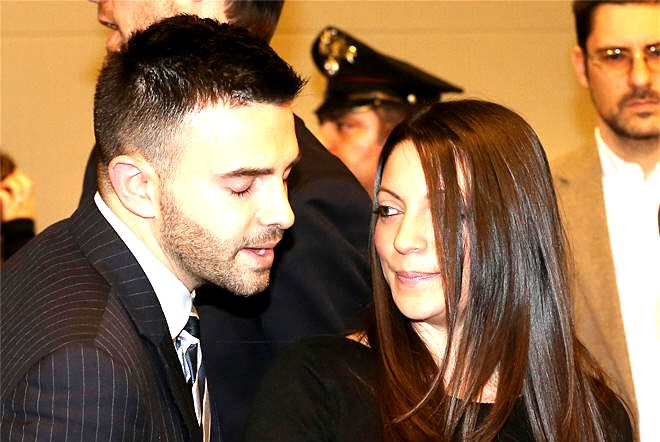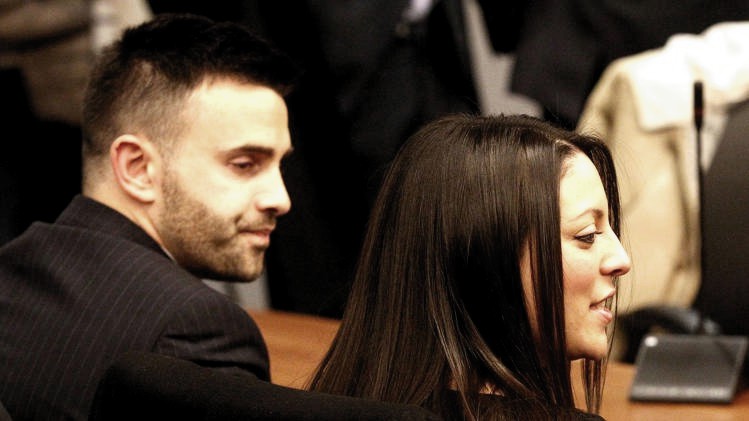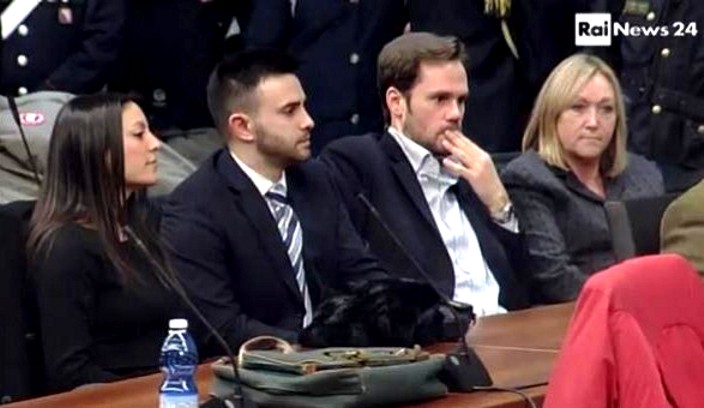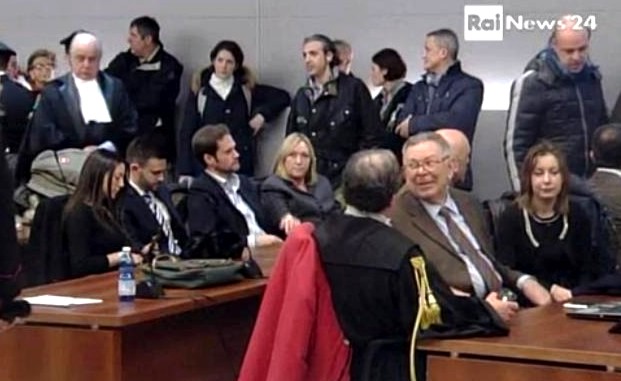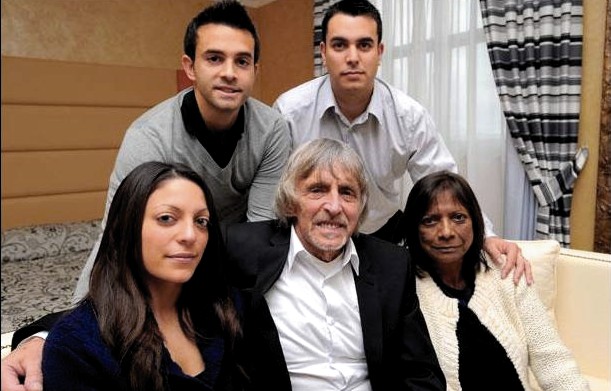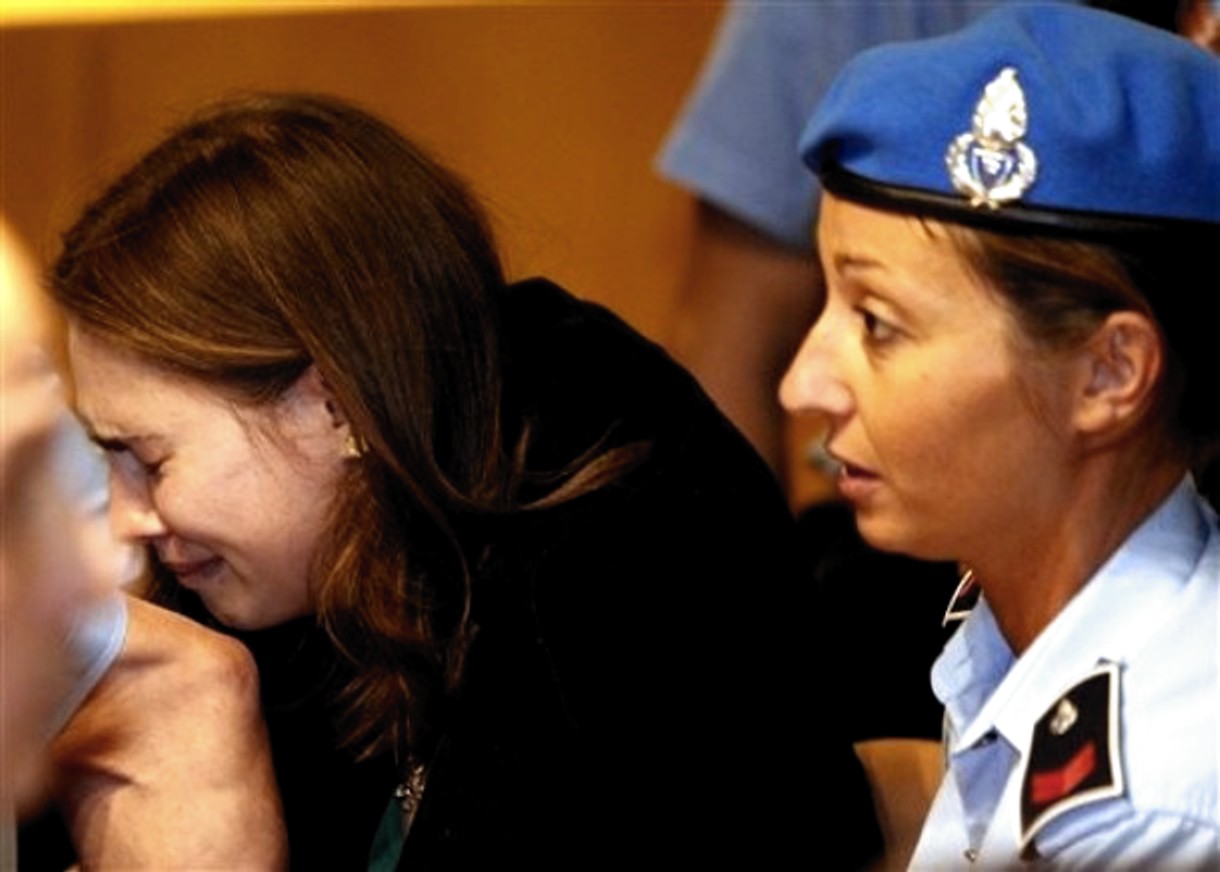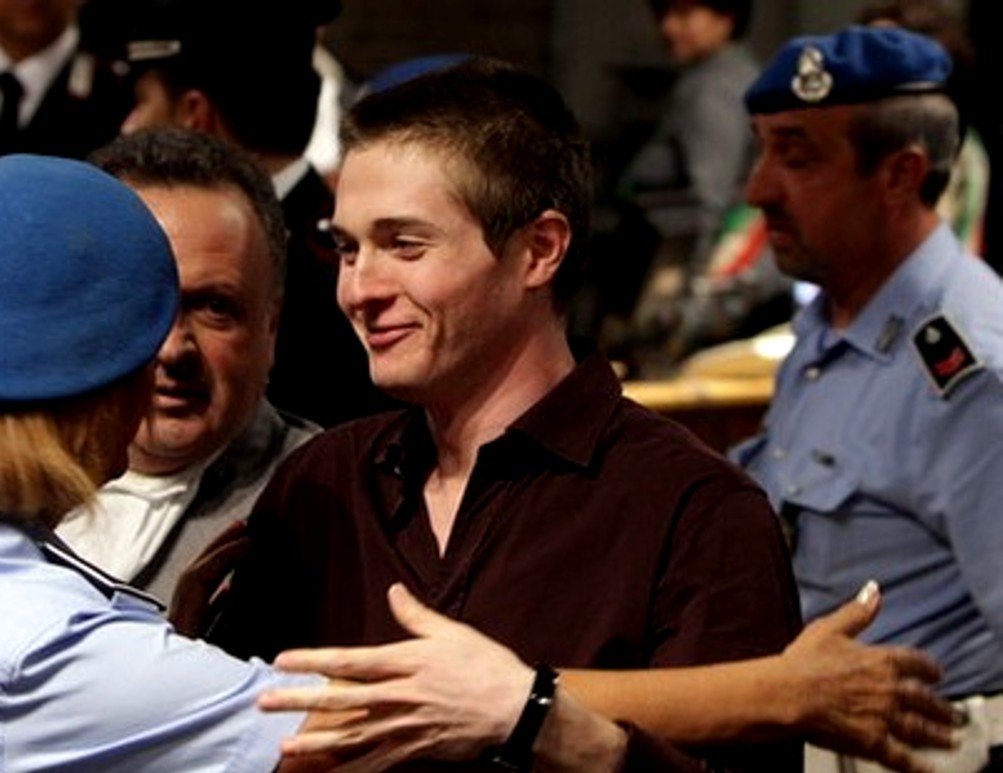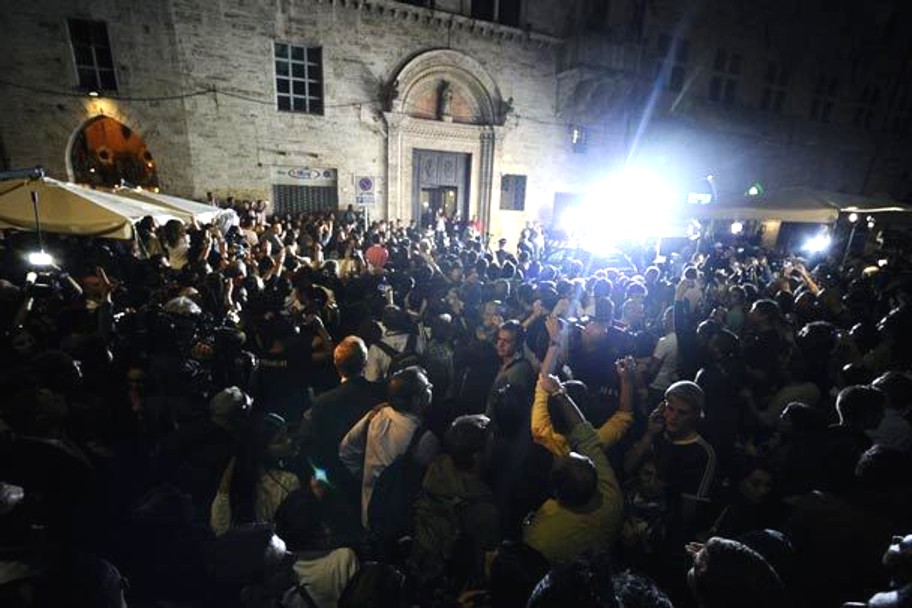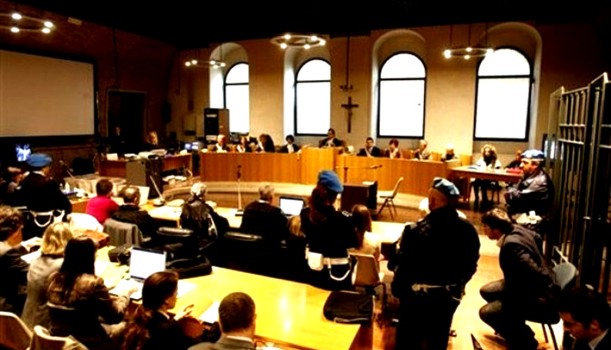
Category: The judiciary
Friday, January 31, 2014
Appeal Session #10 Images: The Attorney General Of Tuscany Dr Tindari Baglione Breaks The News
Posted by Our Main Posters
This help with translation happened right after Judge Nencini finished reading the verdict and sentences yesterday
Below: images of Lyle and Stephanie earlier in the long tense day
Appeal Session #10 Images: The Two Judges And Six Lay Judges Deliver The Guilty Verdict
Posted by Our Main Posters
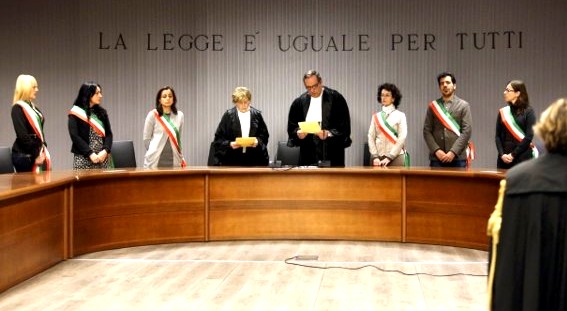
The statement is sharp and quite brief. Judge Nencini confirms that both Knox and Sollecito are confirmed guilty. The 2009 Massei verdict is upheld.
The sentences are 25 years in priosn for Raffaele Sollecito and 28.6 years in rpison for Amanda Knox including the 3.8 years for the calunnia already served. Each must also incur financial penalties.
Both may be locked in the sex offenders wings as both were confirmed convicted with a sex-crime component. Both may face further charges for false accusations of crimes in their books and in the media, as may some of their more strident “supporters”.
Few in the US and UK seem to realize, but the evidence presented at trial in the first half of 2009 was in fact overwhelming. In the US and UK it is probable no appeal would even have been allowed, as the appeal grounds were so flimsy.
Nothing was undermined at the Florence appeal. In fact the evidence became STRONGER as another trace of Knox was found on the big knife. Innuendo about DNA contamination was sharply rejected in face of zero evidence or even scenario.
Please read our case overview here which links to some vital posts and touches on several of the defense’s illegal tricks.
That includes the corrupting of the 2011 appeal, which is well understood in Italy but not registering with most US and UK media - Sndrea Vogt has begun reporting on part of it, the illegal meddling with the Hellmann DNA consultancy
..
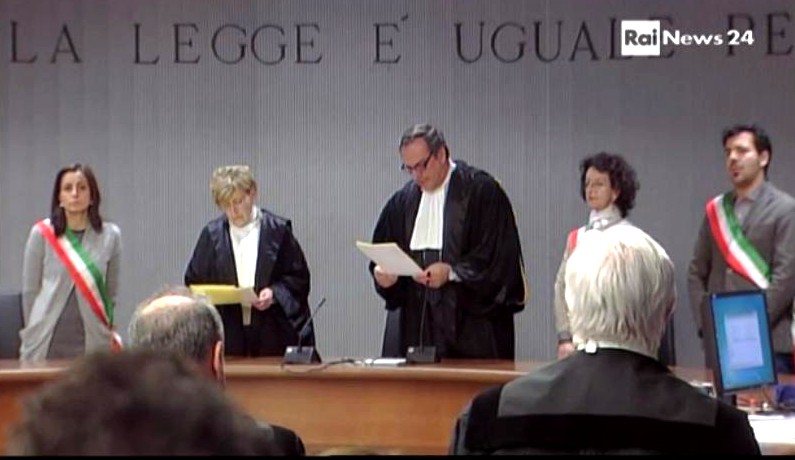
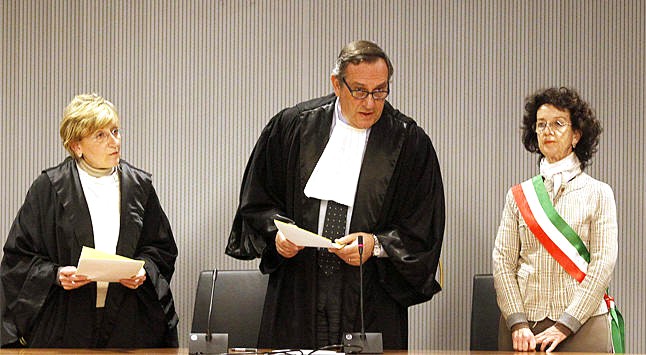
Tuesday, November 12, 2013
Differences Between Micheli, Massei, Hellmann and Nencini Courts Pointing To Almost Certain Outcome
Posted by Peter Quennell
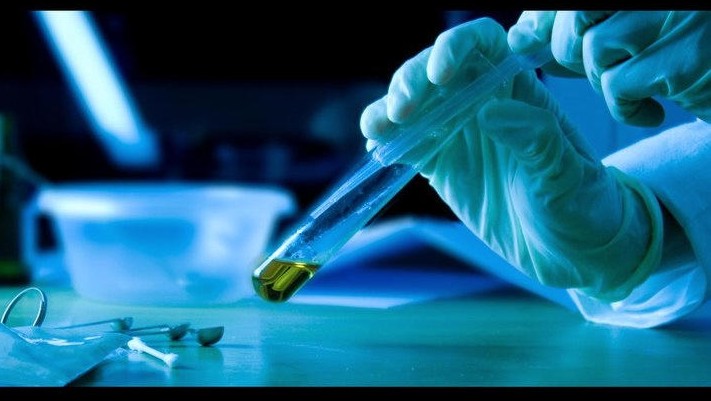
What are the biggest differences? In fact the Supreme Court already pointed them out: science, scope, and balance.
Judge Micheli, Judge Massei and Judge Nencini all have a very extensive criminal-case background. All three have handled many cases of murder, many cases against the mafia, and many cases involving criminal science. All three have remarkable success records and have hardly ever been overturned on appeal.
Judge Hellmann and his court are the extreme outliers. Until forced into early retirement by the Council of Magistrates, he had been a (quite good) business judge. His one major criminal case, years ago, had led to a farcical outcome, and he was ridiculed for this at the time.
Cassation made it very clear that he simply did not reflect a knowledge of the precise Italian law on scope and balance at the appeal level, and that he mishandled the science. In fact, as he actually said, the reason he appointed two independent DNA consultants was that he was at sea on the science.
That left Judge Hellmann’s panel of judges like a rudderless ship, bereft of the kind of good guidance from the lead judge on science, scope, and balance that comes only from many years of experience.
Which, given a level playing field, the pathbreaking Italian system enforces competently like almost no other.
Above all as the Hellmann Report makes extraordinarily plain, his court came to be swayed by the CSI Effect, with the help of two tainted consultants and probably the irresponsible Greg Hampikian in Idaho.
The CSI Effect is a phenomenon very, very unlikely to happen in Judge Nencini’s court. First, take a look at this good explanation of what the CSI Effect is in the Fox Kansas City video.
Many crime shows such as the BBC mysteries and the Law & Order series and spinoffs show investigators solving their crimes in the old-fashioned way. Lots of witness interviews and alibi and database checking, and walking around and loose ends and lying awake at night puzzling. And often there’s a big stroke of luck.
But if you watch the very popular CSI Las Vegas series and its spinoffs in Miami and New York, and the various clones on other networks, you will see something very different indeed.
When those shows first began airing worldwide in the late nineties, the producers explained that audiences increasingly appreciate learning something new when watching a show, and it is true, one sure can load up on the trivia.
But you will also see the US equivalent of Dr Stefanoni and her forensic team in those shows, roaming far beyond the narrow crime scene, interrogating witnesses and checking alibis and finding a lot of non-forensic evidence, and even at times drawing guns.
Most unreal is that, time and again, the forensic evidence testing is clearcut and takes just a few minutes and instantly clinches the case.
- There are several articles like this one and this one on whether the Casey Anthony jury was affected by a shortfall in the starkness of the forensics when the behavioral evidence seemed so strong.
- There are several articles like this one and this one on whether the appeal verdict outcome in Perugia might be affected in the same way.
- There are many articles like this one and this one and this one and especially this one saying there is a tough added burden on investigators and juries without a commensurate improved outcome.
With conviction rates declining in the US and Europe, professionals are taking a scientific look at whether the CSI Effect is one big cause of that decline.
At the macro level in the US this writer doubted that the CSI Effect is fatally unbalancing takes on the wider evidence. The same conclusion was reached in this first major study at the micro level.
But the belief in the CSI Effect continues. Articles like this one on an Australian site talk of a backlash against too many acquittals. Some articles like this one argue that maybe lay juries are out of their depths.
And judges and prosecutions are taking countermeasures.
In Ohio and many other states prosecutors and judges are acting against a possible CSI Effect in their selection and briefing of juries. And an NPR report came up with these findings.
Some states now allow lawyers to strike potential jurors based on their TV habits. Judges are issuing instructions that warn juries about expecting too much scientific evidence based on what they see on TV.
In the field, Shelton says death investigators sometimes run useless tests, just to show they went the extra CSI mile.
“They will perform scientific tests and present evidence of that to the jury. Even if the results don’t show guilt or innocence either way, just to show the jury that they did it.”
This is coming at a time when death investigators in America have no resources to spare. An investigation by NPR, PBS Frontline and ProPublica shows some states have already opted not to do autopsies on suicides, others don’t autopsy people who die in traffic accidents, and many don’t autopsy people who die over the age of 60.
But Murphy, the Clark County coroner, expects things to get worse.
“You know, we’re in budget cuts right now. Everybody’s in budget cuts. Las Vegas is no different than anybody else. We’re hurting. We’re going to feel that same crunch as everybody else,” he says.
One of Zuiker’s great disappointments is that, for all its popularity, his fictional Las Vegas crime lab didn’t generate more political support to fund death investigation.
“I’ve done my job. You know, we’ve launched three shows that cater to 73.8 million people a week and is a global phenomenon and the largest television franchise in history. We hoped that the show would raise awareness and get more funding into crime labs so people felt safe in their communities. And we’re still hoping that the government will catch up.”
None of the science in Meredith’s case has ever been discredited in court. Even in Judge Hellmann’s court the agenda-driven independent consultants Conti and Vecchiotti failed - and under cross-examination admitted it.
Also remember that the Hellmann court did not get to see two very key closed-court scientific presentations (the stark recreation of the attack on Meredith, in a day of testimony, and later in a 15 minute video) which had a very big balancing effect on the Massei court.
Right now the reputation of not one defense-campaign stooge who has attacked the science remains intact.
Greg Hampikian has headed for cover. He had widely proclaimed that he clinched the Hellmann court’s outcome, in an act which may well have been illegal. Unsurprisingly, he is now trying very hard to hide his own claimed “proof ” of shortfalls in the science, as Andrea Vogt has been showing in her Boise State University investigation, and as we will soon post more on.
Saul Kassin is another defense-campaign stooge who falsely claimed that he clinched the Hellmann court outcome by “proving” a false confession by Knox - in an interrogation that never even took place.
Despite all of this, maybe as straw-snatching, we can again see an organized attempt to confuse American opinion on the science of the case.
Whether she did this intentionally or not, that is what the PR tool Colleen Barry of the Associated Press was doing when she omitted that the trace of Meredith on the knife is undisputed hard evidence.
Judge Micheli and Judge Massei handled the science, scope, and balance with some brilliance. In all three dimensions Judge Hellmann fell short abysmally.
What is your own bet on the outcome under the exceptionally experienced Judge Nencini?
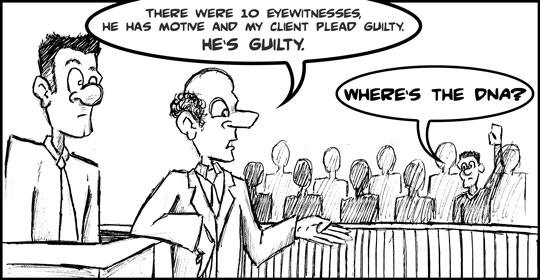
Parts of this post were first posted in 2011 after the disputed and much examined outcome of the Casey Anthony murder trial..
Wednesday, October 02, 2013
Appeal Session #1(B) Detailed Report On Enquiries The Court Has Okayed
Posted by Our Main Posters
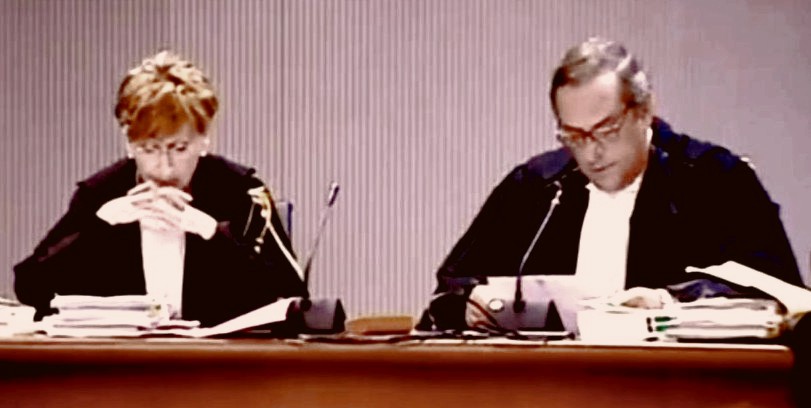
[Above the two co-judges with lead judge Allessandro Nencini reading the case history]
Explanation
The previous post listed what has already been agreed to by the court to guide the appeal. This report which only became available later describes what had been the prosecution and defense requests.
Translation From The Umbria24 website
Meredith, war of requests in the first hearing of the 2nd Appeal
The court has order a new test on the I trace and on the hearing of the witness Luciano Aviello. Rejected all other requests
By Francesca Marruco
After a little over 2 hours in counsel chambers the Florence Court of Appeals has decided to order a new test on the trace evidence of the knife seized in Raffaele Solecitto’s apartment, the weapon presumed to have been used in the murder.
The Court has also decided to hear the witness Luciano Aviello but rejected all the other requests for renewal of investigations presented by the defense. The Court resumes on Friday with Aviello and the assignment of the task of the new genetic analysis to the Carabinieri del Ris of Rome.
[The appeal] this morning in the maxi courtroom no. 32 of the Florence Justice Courthouse, commenced the new appeal for the murder of Meredith Kercher, after the annulment of the acquittal by the Supreme Court.
Present in the courtroom was only Patrick Lumumba. Absent, as expected, were the two appellants, Amanda Knox and Raffaele Sollecito.
- 9:00 Francesco Sollecito, father of Raffaele, says he is tranquil about the outcome of the new trial. Responding to journalists, he specified “The statement of the Supreme Court is compromised by errors committed because the judges did not have full access to all of the proceedings, as they themselves indicated.”
- 9:45 The defense of Knox and Sollecito have asked for the exclusion of the Patrick Lumumba (civil) party because the conviction of Amanda for calunnia has already been passed into final sentence.
This request was opposed by the General Prosecutor Alessandro Crini, and the lawyer of Lumumba. For them the plaintiff’s civil right is legitimate, as the Supreme Court has asked this court to re-evaluate the penalty in light of the finalized sentence of Knox.
The Court retired to counsel chambers to decide, announcing it wanted to decide today on any reopening of the investigation.
- 10:15 The court rejects the request of the defense of Knox and Sollecitto to exclude the civil party Patrick Lumumba, because the Court specifies that, among other things, the offense was not assessed in totality by the trial court.
- 10.50 The President of the Court of Appeals, Allessandro Nencini, is initiating his introductory report, starting from the day of Meredith’s homicide. The judge travels trough the most important passages of the three Courts. Speaking of the trace, secured by the consultants of the second [Hellman] Court, on the knife (considered the weapon of the crime by the first Court) President Nencini said: “It is necessary to underline that the independent consultants had found another trace; but it was not analyzed”.
- 11:15 The President of the Court, Judge Nencini, at the end of the introductory report, said: ” This is an appeal for matters of undeniable seriousness beyond the media spectacularization. Thus the Court is willing to give all possible space for debate to all of the parties, because originally there was a solid verdict, and the actions on which we proceed are of undeniable seriousness”
- 11.25 Raffaele Sollecito defense lawyer Giulia Buongiorno was the first to take the floor.
]Bongiorno:] Sollecito’s defense does not ignore the motivations of Cassazione, and we are in favor of any kind of verification that the Court will order, with the following caveats. This proceeding has always been based on two types of evidence, the testimonial and the technical. We request that during this proceeding, which we hope to be the last one, that the Court during the next hearings will concentrate only on the truly reliable evidences, putting aside those that are nullified by media conjecture.
Many witness have said things because they have read them or heard them. The proceeding was reopened, but not to collect this type of guesswork. We do not want to inflate this proceeding with new conjectures. We request to examine in depth the crime observed, as emphasized by Cassazione. In the crime scene room there are copious traces of two of the four claimed present persons, the victim and Rudy Guede who admitted to having been there, and none of the two appelants except on the hook of the victim’s bra.
When the Prosecutor asserts that there are no traces because Amanda and Raffaele cleaned them, we think that this is impossible. For this reason we request to have a evaluation done in order to verify if it is possible to clean selectively… A Cassazione mistake was that it didn’t notice the entry into the crime scene room before the bra hook was found, so we request the acquisition of two reports [on that].
We want to understand if in a sealed place it is possible to get firm evidence even after the admission by the police of other searches. We do not request to simply take the hook and to say that it is contaminated, we want to know if in that environment it was possible to collect some genuine evidence, because at the crime scene there were not ten traces of Raffaele but only that one”.
A subordinate request by Giulia Buongiorno is that experts, new experts or the ones at the Hellman appeal, will read the electropherograms. Buongiorno requests the analysis of both of Meredith Kercher’s cell phones that she consider the “black box” of the crime and that they “were never analyzed deep enough by the Corte d’Assise di Perugia” The defense requests also analysis of the presumed sperm trace on Meredith’s pillowcase.
- 12.15 Amanda Knox defense lawyer Carlo Della Vedova takes the floor and raises right away an exception to the judge’s stipulations. “Are we today able to judge on matters that happened six years ago? Can a person be under proceeding for life? Are we sure that Amanda Knox is an accused like all the others? Is it right, the indefinite delay of this proceeding? For all of this I insist that the Court evaluate the constitutionality.”
- 13.00 The Kercher family’s lawyer produced a letter written by the family members of Meredith that read “We are confident that the evidences will be reexamined and all the requests of more evidences will be granted, in a way that all the unanswered questions will be clarified and that the Court can decide on a future way of action in this tragic case. The past six years have been the most difficult of our lives and we want to find an end and remember Meredith as the girl that she really was rather than remember the horror associated with her”.
-14.00 The General Prosecutor Alessandro Crini says he is against the request of the defense to hear anew from some witnesses, including Rudy Hermann Guede. The same argument Crini voiced for the majority of the requests of the opening introduction presented by the defense. In conclusion, he asked for the the addition of the evaluation of the “I” trace, isolated by the independent experts, but never analyzed because they claimed it was believed to be Low Copy Number. Furthermore the prosecutor asks that the witness Aviello be reheard.
-15:00 The lawyers of the civil part that represent the Kercher family support the request of the General Prosecutor Crini, and opposed the requests of the defense. The lawyer Francesco Maresca said he believes that the defense attempts to frame with a new “dress” evidence that is strong, resistant, and robust, from the findings of the trial court, and that were minimized by the first appeal court. For example, the witness Capezzali.
Also there are newly framed certain requests that are obsolete, that have already been actioned. Like that of the selective cleaning. In the bathroom next to the room of the crime, there were many mixed traces of DNA of Amanda and the blood of Meredith. And the genetic profile of Sollecito, besides on the bra hook, was present only mixed with that of Amanda on a cigarette butt, then how did it migrate, only that one, from the cigarette butt to the bra hook?
- 15:10 The defense of Raffaele Sollecito maintains the request to analyze the “I” trace, but opposes hearing from the witness Luciano Aviello. Buongiorno also pointed out that it is not true that the independent experts of the second court decided automatically to not analyze certain traces, but did so in the presence of the prosecution experts Stefanoni and Novelli and those of the defense. Carlo Dalla Vedova, for the Knox defense, said that Avelio should be heard only to demonstrate that the police uses him two different ways. Like when Avelio said he knew where the crime weapon was.
- 15.30 The Court retired in council chamber and announced that will not come out before 17.30
Conclusion
Thereafter the court convened again and the decisions were as outlined in our post below this one. Almost all of what the defense had argued for - each of them a stretch if you know the full circumstances - was denied.
And the two main requests from the prosecution - that Aviello be put back on the stand, and the large knife be retested - were accepted. Ourcomes of these may or may not add to the strength of the prosecution’s case, but seem to offer no prospects of joy for the defenses.
Friday, September 13, 2013
Lead Judge Is Now Confirmed And Court Dates Announced For The Florence Appeal
Posted by Peter Quennell
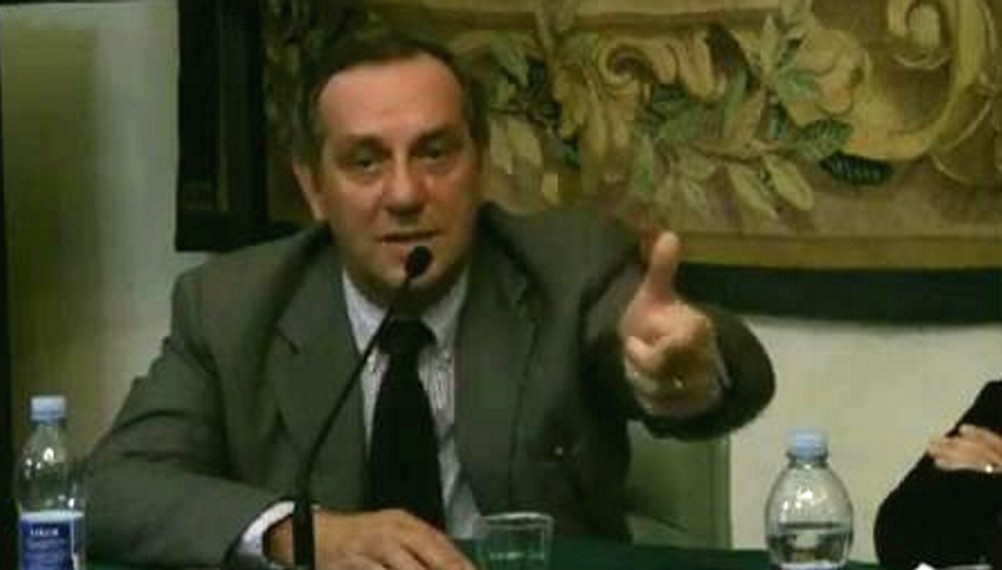
Above: the formidable senior appeal judge Dr Alessandro Nencini who will preside over the appeal.]
September 30; October 4, 23, 24; and November 6, 7, 25, and 26.
These are the dates the Florence appeal court will meet. Corriere and other Italian media sites are confirming these as the dates.
It is confirmed that Judge Alessandro Nencini will preside over the appeal in the Palace of Justice’s Courtroom 32. He is a very senior judge. As the ANSA News Service mentions, Judge Nencini is the President of the Second Chamber of Appeal of the Florence Court.
The new Prosecutor General of Tuscany (Florence’s region) Dr Tindari Baglione, the chief prosecutor of Tuscany’s appeal court, is selecting the prosecutors for the appeal. He arrived in Florence in May of this year. He is said to be formidably unbending. He recently imposed tough sentences on 27 people for the environmental damage caused by illegal work in Mugello on the high speed rail link between Florence and Bologna.
Already appointed as the lead prosecutor is Dr Alessandro Crini. He was among the Florence prosecutors who handled the investigation into the murders by the Monster of Florence and also the mafia massacres of 1993. In the Monster of Florence case he was a deputy to the leading prosecutor Dr Paolo Canessa, the main prosecutor of the last and final MoF trials.
There are at least seven pieces of bad news for the hotheaded among the Knox-Sollecito faction coming down the pike, some already mentioned in this recent post here..
- 1) Prosecutors Paolo Canessa and Alessandro Crimi carried out their MoF investigations in cooperation with Prosecutor Giuliano Mignini of Perugia. We believe it was they who first involved Dr Mignini in the MoF case by explaining the possible MoF connection with the Narducci murder Dr Mignini was investigating. Dr Mignini has no role in this appeal, but they had obvious confidence in him..
2) Giulia Bongiorno may be leaving the Sollecito team. Sollecito himself has done an immense amount to embarrass her with his defamatory book and narcissistic TV claims. The new lawyer Dr Mastro is said to be a relative of the Sollecito family and has been harshly critical of the Bongiorno defense line of joining Sollecito to Knox at the hip. He would presumably separate Sollecito from Knox, and may throw Knox to the wolves if it helps.
3) The trial of Luciano Aviello will be running in Florence during the same time as the appeal. Each could explosively impact the other. We explained the extraordinary implications of this trial for the Knox and Sollecito entourages in this past post also linked to just above.
4) The trial of Frank Sforza for criminal defamation will start in Florence on 6 November. A prosecutor will bring this case, it is not a simple calunnia case brought by those Sforza abused. We have a new post pending which will explain the many nasty implications for the FOA. Its testimony could also spill over into the Knox-Sollecito appeal.
5) The appeal outcome is expected to be arrived at by the latest in December. Knox and Sollecito wont have to wait long to hear the probable outcome: guilty as charged. Whether either will appear in the court seems doubtful, but a no-show will do them no good. A coward’s move.
6) The chief prosecutor in Florence is expected to announce any time now what charges will be brought against Raffaelle Sollecito and his publishers for the many false accusation of crimes and malicious mis-statements of evidence he foolishly included in his book. At least one could incur a substantial prison sentence: Sollecito’s false accusation that the prosecution sought a deal whereby he would turn on Amanda Knox in exchange for lesser charges.
7) The chief prosecutor in Bergamo north of Milan is expected to announce any time now what charges will be brought against Amanda Knox and her publishers and Oggi for the many false accusation of crimes and malicious mis-statements of evidence she foolishly included in her book. At least one all by itself could incur a prison sentence: Knox’s false accusation that the prosecution forced her in an illegal interrogation into framing Patrick Lumumba.
Those who appear to us realistic about the minefield they face include the defense lawyers (who are rumored to be very despondent) and those who have detached themselves from the pro-Knox forces and quite possibly Curt Knox himself who of late has been quiet for sure.
Those who still maintain a crazed and abusive hard line appear to be only Bruce Fischer and the Mellas family including Chris, Edda, and close relatives. Fischer seems to us unlikely to grow a brain before he is dragged to court, but it is possible that the Mellas family might. They have taken down all traces of one of the many defaming websites Chris Mellas is known to have put up, the final Perugia Shock.
Also when he overstayed his welcome at their house they threw Frank Sforza out.
[Central Florence at night with Palace Of Justice faintly visible behind at left-center; click to enlarge]
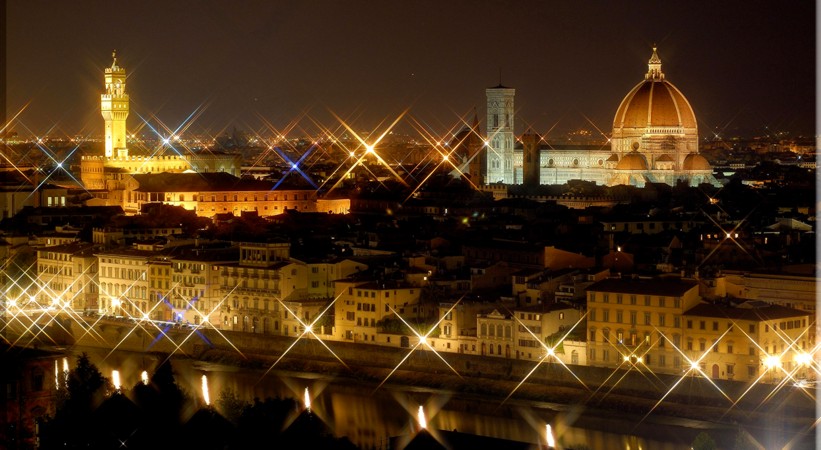
Thursday, August 02, 2012
Dissecting The Hellmann Report #3: How Zanetti & Hellmann Bizarrely Try Discredit Witness Curatolo
Posted by Cardiol MD

[Stone steps Meredith and all three accused maybe used on the night; left and at bottom, where witness sat]
Under the first post in this series dissecting The Hellmann Report, one of our percipient commenters suggested this:
The next portion in the series should likely be about the witnesses, I hope, and there we can marvel at Hellmann’s discourses on the functioning of the human memory.
Was our commenter ever right!
On page 32 of the PMF English language version of “Sentence of the Court Of Assizes Of Appeal Of Perugia (Presided Over By Dr. Claudio Pratillo Hellmann)” this is written:
The presence of Amanda Knox and Raffaele Sollecito in Piazza Grimana between 9:30 PM and 11:30 PM on November 1 was, in fact, reported solely by the witness Curatolo, whose reliability this Court very much doubts for the following considerations.
In the first place, the deterioration of his mental faculties, from his way of life and his habits. revealed by his answers before this Court in the course of his testimony (hearing of March 26, 2011) resulting from his way of life and his habits
Realisation of what Hellmann/Zanetti were “constructively” doing there stunned me. They are exposing both a lack of logic and prejudice against a witness.
A necessary logical preamble to my realisation goes as follows:
- 1. Massei had stated that Antonio Curatolo’s declarations have “been established to be reliable” [MASSEI p.358 of 397 [28th of 42 total Curatolo references]].
2. Hellmann/Zanetti stated that “..this Court does not recognise the statement made by the witness Curatolo as credible”¦ [Hellmann/Zanetti p35 of 95 [5th of 18 total Curatolo references]]
3. In American common-law appellate courts do not rehear the facts of the case. Appellate courts focus on questions of law, NOT on questions of facts as their trial-courts do.
The American appellate judges don’t presume to supersede the people who were there, and who watched the witness’s demeanour and surrounding activity, in 4-D (3-D + Time), with sights, sounds, cadences, pauses, pronunciations, intonations, and yes, “¦smells, in addition to, and supplementing, the 2-D pieces of paper, containing only the words they apparently spoke, but not containing the way they spoke them, let alone the scene before the court.”
The American appellate judges want only to know whether the law was applied accurately.
Those American appellate courts overrule a trial court decision only if a very important legal error was made in the trial court.
In some cases, the American appellate court judges might believe that the outcome of the trial court should have been different, but if no legal errors were made, they will not overrule the lower court.
The American appellate judges make their decisions based only on legal arguments of how the law should be applied and interpreted.
Our learned English & Welsh Common Law (E&W) correspondent has explained to us that E&W law permits Appellate introduction of fresh evidence, which could include new evidence re rain and buses, although Massei had already considered evidence on those subjects.
E&W Law would not have allowed Appellate re-examination of Curatelo.
4. As we all know, and have discussed in some detail, Italian law is significantly different but Dr Galati is apparently outraged by the conduct and Motivazione of Hellmann/Zanetti.
Dr Galati has lodged a strongly-worded Appeal of Hellmann/Zanetti’s verdict, alleging that the scope of Hellmann/Zanetti was illegal and that they tried to run a whole new appeal trial.
Galati indicated in the appeal to Cassation that the Hellmann/Zanetti reveals “contradictoriness/contrariness and demonstrates manifest illogicality in the grounds for the judgement/reasoning report””¦
See also my previous post on the definition of “unreliable” [in the Hellmann Report] with reference to the witnesses Antonio Curatolo.
Although I can identify no specific reference by Dr Galati to the specific issue re Curatolo I wish to address, this one should have been included:
- i. “the deterioration of his mental faculties”, apparently between Curatelo’s testimony at the Massei hearing of March 28, 2009, and Curatelo’s the Hellmann/Zanetti hearing of March 26, 2011.
ii.Suppose Curatolo’s faculties really did deteriorate during those 2 years; maybe he was injured in an RTA, had a stroke, or developed a dementia.
What on earth has that got to do with Curatelo’s testimony back in 2009? It’s possible that Hellmann/Zanetti were implying that Curatolo’s “deterioration” was part of a continuum, and that as bad as he was, in their opinion, in 2007, 2009, and 2011, he had been, and still is steadily getting worse.
If that is their implication they would be committing 2 cardinal errors of logic ““ the interpolation error, and the extrapolation error.
Of course, giving their words their plain-meaning, Hellmann/Zanetti could be implying acceptance of the Massei’s statement that Curatolo’s 2009 testimony was reliable ““ but they obviously do not intend to imply that.
iii. Maybe Hellmann/Zanetti can get away with dismissing Curatolo’s testimony to Massei “presuming to supersede the people who were there, and who watched the witness’s demeanour and surrounding activity, in 4-D (3-D + Time), with sights, sounds, cadences, pauses, pronunciations, intonations, and yes, “¦smells, as well as the 2-D pieces of paper, containing only the words they apparently spoke, but not containing the way they spoke them, let alone the whole scene before the court. ”
I hope not, but with this “deterioration” allegation, there is no apparent (even an inadmissible one) professional expert opinion in evidence, and with Hellmann/Zanetti’s gratuitous cause-and-effect theory: “resulting from his way of life and his habits “, Hellmann/Zanetti overstep, and reveal their ignorance, arrogance, and incompetence.
Finality, in Anglo-American common law, is the concept that certain disputes must achieve a resolution from which no further appeal may be taken, and from which no collateral proceedings may be permitted to disturb that resolution.
Does Italian law really allow this 2-years-later Appeal-rehash of witness testimony and criticisms, on the grounds that the witness’s memories have faded since he first testified? I hope not.
Isn’t it normal for memories to fade with the passage of time?
Does that fading justify dismissal of the original testimony?
A principle of Anglo-American Common Law deeply embedded in it - Finality - would be out-of-the-window if lawyers could just keep repeating their questions until the witness gives them what they want.
Between their substitution of “certainty” for “reasonable-doubt” and their would-be eternal-postponement of finality Hellmann/Zanetti could shoot their legal system out of the courts.
Hellmann/Zanetti’s treatments of Curatolo’s testimony, alone, is a disaster. They should be thrown-out.
Hellmann/Zanetti’s subtext seems to be that Curatolo is merely an ignorant, illiterate, bad smelling, unkempt, dirty, ugly-old-tramp, daring to testify as to what he observed, to the detriment of two knowledgeable, educated, sweet-smelling, tidy, clean, attractive, young, innocent children.
Isn’t it far more certain, Hellmann/Zanetti seem to think, that the testimony of Curatolo is false testimony, and that the false testimony of these charming young children is not really false testimony because the Devil Prosecutors made-them-say-it.
If I analysed that whole section it would be very long.
If you are not yet familiar with them, you should read in conjunction with this series the posts by one of my lawyer colleagues on TJMK. James Raper, explaining the strength of the prosecution case and how hard it is to challenge legitimately.
See here and here. Also here by another of my lawyer colleagues, SomeAlibi.
[Below: witness said he and perps sat on benches at left; Meredith’s house far left, steps far right]

Wednesday, June 06, 2012
Action On Dr Galati’s Appeal To The Supreme Court Today Moved Ominously Closer
Posted by Peter Quennell
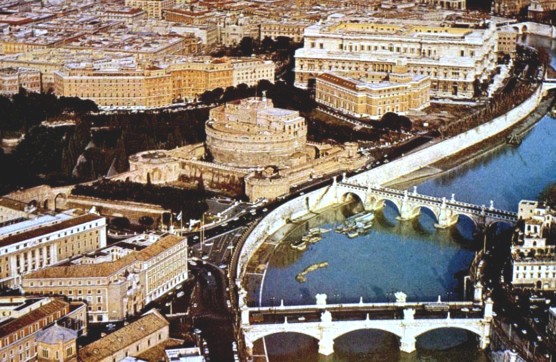
[Italy’s Supreme Court of Cassation is the large structure at right background]
The ANSA news service is reporting today that Dr Galati’s appeal was formally accepted by the Supreme Court on 15 May.
The case has just been assigned to the First Criminal Division of the Supreme Court which is responsible for appeals involving murder. A hearing and outcome which could involve the appeal being punted back to Perugia to be done again properly might be expected in about seven months.
Still no word from Sollecito or Knox or their teams about the exceptionally tough appeal Dr Galati filed against Judge Hellman’s interim verdict releasing them. Our Italian lawyers are surprised that there has been no announcement of any new legal help.
Do the still-accused or their families understand what is about to hit them? Cassation appeals are considered very specialised and certain Rome lawyers make a good living doing nothing but handle them.
Dr Galati was a deputy chief prosecutor at the Supreme Court and would seem to have the Knox and Sollecito teams who are inexperienced at that level thoroughly out-matched. If Knox fails to appear at any appeal trial re-run she would lose the advantage of personalising her own plight with the help of her flash-mob in the court.
In Italy there is enormous suspicion that politics and money played roles in bending the outcome the last time around. The prosecution clearly felt that, and there seems a good chance the full story will not remain hidden.
We also hear that the continued rabid postings of Curt Knox’s hatchetmen are increasingly under the microscope. No sign their campaign does anything but hurt. It sure put real resolve into this appeal.
Monday, October 03, 2011
Knox And Sollecito Declared Not Guilty But With Angry Booing Outside The Courtroom
Posted by Peter Quennell
Sunday, June 19, 2011
The Massei Sentencing Report For Knox And Sollecito: Part 1 Of A Summary In 4 Parts
Posted by Skeptical Bystander
Why This Long Summary
The full Massei Report can be found here.
The wiki page controversy surrounding the murder of Meredith Kercher rages on in a tiny corner of the online universe, here is our own contribution to the debate.
It is a 4-part summary of the Massei report, the document that sets forth and explains the Court’s reasons for unanimously convicting Amanda Knox and Raffaele Sollecito for their role in the murder of Meredith Kercher, Knox’s roommate, after a long, thorough and fair trial.
Please click here for more
Saturday, December 18, 2010
The Appeal’s Set Limits: What The Judges Allowed Today And Didn’t Might Tell Us A Lot
Posted by TomM
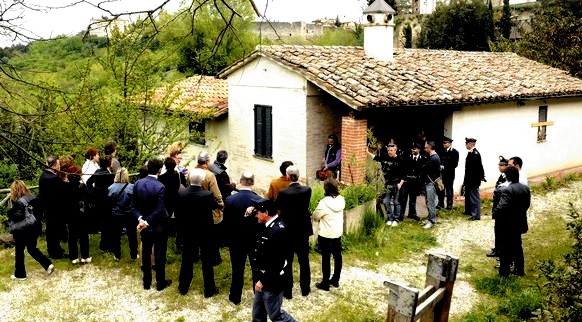
[Massei court deciding whether to buy spiderman theory; they didn’t]
1. The Context Of These Remarks
The judge ruled on the appeal’s inclusions and exclusions today. I’ll summarise what they are and how American courts might have differed.
I really do not understand why the defense and the family are so happy with this review, which is very limited and not complete in any sense - other than, perhaps, the “any port in a storm” phenomenon.
From my view in the bleachers, there are way more risks to the defense than to the prosecution from Saturday’s rulings.
2. What’s Allowed In Italian Appeals V. American
As a California lawyer familiar with trials and appeals in my state, watching the Meredith Kercher murder trial wind its way through the Italian legal system has been a learning experience.
It is a system with more protections than the one I know first-hand. The case is now in its first appeal phase, and proceeds far differently from the way it would in the US.
- If Knox and Sollecito had been convicted in an American court (which an American court would have had no difficulty in doing) less helpful presumptions would be applied to their appeal.
- In Italy they are convicted, and for that reason they are imprisoned and the visitation privileges they had before the jury’s verdict have been reduced. But for purposes of weighing the evidence in the appeal, they are presumed innocent.
- In the US, the court of appeal would not presume them innocent or guilty; it would regard them as having been adjudged guilty.
- In Italy, they can ask for the court of appeal to hear testimony from new witnesses and seek to introduce additional evidence.
- In the US, the appeal would be on the basis of the clerk’s and reporter’s transcripts of the trial. In the US the jury at the original trial would have been instructed that if an item of evidence can be interpreted two ways, one favoring guilt and one favoring innocence, they should accept the interpretation that favors innocence. But not so on appeal; the court of appeal would interpret all the inferences from the evidence in the light most favorable to the prosecution.
- An American court of appeal would not consider an attack on the credibility of a witness unless the testimony was such that no reasonable person would believe the testimony.Thus, an attack on the testimony of Curatolo would have no chance of success on appeal. In fact, jury instruction in the US would give the jury blessing to believe him even absent disco buses running that fatal night.
From a form jury instruction on how to judge witness credibility:
“Do not automatically reject testimony just because of inconsistencies or conflicts. Consider whether the differences are important or not. People sometimes honestly forget things or make mistakes about what they remember. Also, two people may witness the same event yet see or hear it differently.”
The Italian appeal is described as a “trial de novo”.
- In common law jurisprudence, a trial de novo is simply a new trial, and the jury in a new trial would not even be told of the existence of the first trial. It would be done as if the first trial never happened.
- Not so in Italy. The jury and lay judges have full access to the case dossier, the Massei Motivazione, and the briefs of the parties. They decide which parts of the case should receive new evidence, and the parts where none is needed. If that were not the case, they would not know how to respond to the defense requests.
3. Tellingly, What Court Has NOT Re-opened
1. Staging Of Burglary
It is significant that there is no re-visit on the staging of the burglary. This charge is not just one of the things used to prove the murder, it is also a separate charge which does not require that a person also have participated in the murder.
Let’s suspend disbelief a moment. Suppose AK and RS had not been present during the murder, having ducked out briefly to get more drugs, but returned to discover Meredith’s body.
Suppose they thought they would be suspects because they had let Rudy in and feared they would be blamed, so they staged the burglary to divert suspicion from themselves. In this hypothetical situation, they are still guilty of staging a burglary even if they didn’t otherwise participate in the crime.
So, what to make out of the fact that no further evaluation will be made of the staging?
This seems like the easiest of the charges to prove and the most difficult to defend. Staging is a recognized phenomenon in criminal investigations and the defense expert did not fare well under cross-examination. I don’t see how the court would reverse the judgment on this issue given the state of the record.
2. Collection Of DNA
Defense criticized the way the dna was collected from the bidet, but there will be no review of that evidence - or of any other of the mixed blood/dna evidence - only the knife and the bra clasp.
If the appellate jurors’ inclination were to think there is reasonable doubt on the dna, there is plenty of defense expert testimony to hang that hat on. That only two of the exhibits will be studied shows that they do not question the work of the scientific police as a whole.
4. The Pattern Of Sorts In These Rulings
From my own experience, I firmly believe that Hellman has not made up his mind on the final outcome. That doesn’t mean he doesn’t know what he thinks the jury will do with the case.
He clearly knows the case, and I think he knows if there are areas in Massei’s reasoning that have vulnerabilities (not necessarily fatal) that could attract attention in the Court of Cassation.
I think he knows whether the prosecution’s case is a house of cards, or if it is a good case with some curable cosmetic flaws.
To me, the rulings look like the judge has reviewed the case, thinks it is fundamentally sound, and believes it will be backed up by unbiased expert opinion - and if it doesn’t, he will assess what impact that has on the case.
The issue with respect to the scientific police is not that they were biased in the sense of falsifying evidence to wrongfully convict, but that the video of the crime scene investigation showed non-textbook acts, Stefanoni didn’t leave a complete paper trail in testing the knife, and they failed to collect and correctly bag the bra clasp at the beginning.
All of which left an opening for the defense to claim the dna evidence is suspect. There is a reason why teachers don’t let students grade their own papers, I think that concept is behind Hellman’s decision to seek an unbiased review of these two items.
5. No Signs Of Exoneration In Rulings
If Rudy Guede testifies and gives a believable narrative, it may not matter what the two dna reviews say, and it might also undermine the jurors’ inclination to accept the theory of remorse from the covering with the quilt that persuaded Massei to reduce the sentence.
An increased sentence is not out of the question.
As I said at the top, I really do not understand why the defense and the family are so happy with this review, which is very limited and not complete in any sense - other than, perhaps, the “any port in a storm” phenomenon.
The bra clasp evidence is not going to go away, and there is the risk that increased technical sophistication could result in identifying a complete dna profile of Amada Knox on it. If they disassemble the knife, there could be abundant blood between the handle and the blade.
Again, from my view in the bleachers, there are way more risks to the defense than to the prosecution from Saturday’s rulings.

